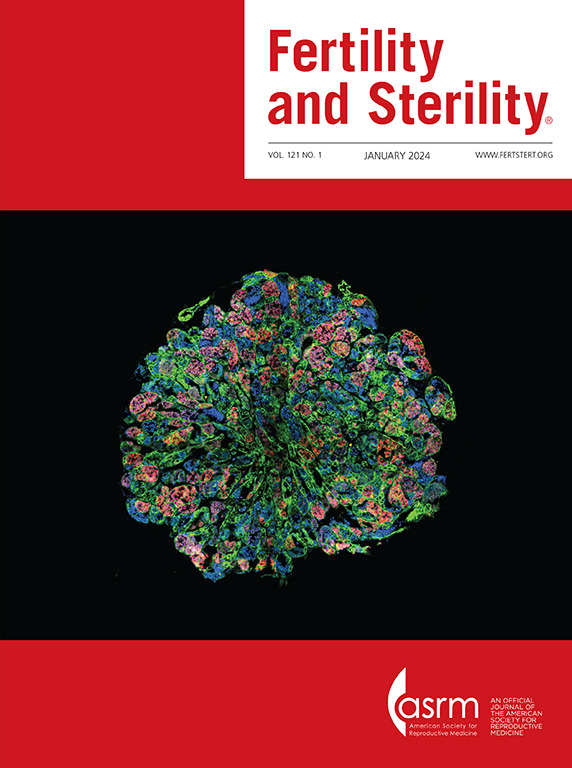Impact of Clomiphene Citrate on Multiple Gestation Births and Perinatal Outcomes: A Nationwide Cohort Study.
IF 6.6
1区 医学
Q1 OBSTETRICS & GYNECOLOGY
引用次数: 0
Abstract
OBJECTIVE To evaluate the occurrence of multiple gestation birth and perinatal adverse outcomes in pregnancies resulting from clomiphene citrate (CC) treatment compared to non-exposed pregnancies. DESIGN Nationwide cohort study in an university hospital-based research center. SUBJECTS Pregnancies lasting more than 22 weeks of gestation, in women aged between 18-43 years between 2013 to 2019, recorded in the French health data warehouse (SNDS). EXPOSURE(S) Pregnancies exposed to CC were assigned to a 1:5 unexposed control cohort based on maternal age, calendar year of childbirth, French social deprivation index, history of hypertension and diabetes. Exclusion criteria were IVF/ICSI treatment or gonadotrophins within 12 months before pregnancy and pregnancies occurring in women with the dispensing of CC between 12 to 2 months, and/or less 11days before the beginning of the pregnancy. MAIN OUTCOME MEASURE(S) Multiple gestation birth rate and perinatal outcomes RESULTS: Of 3,173,013 pregnancies, 32,010 (1%) occurred in women exposed to CC, of which 31,934 were assigned to 159,670 unexposed control pregnancies. The multiple pregnancy rate was significantly higher in CC-exposed pregnancies (5.2% versus 1.4%; odds ratio (OR) 3.9, 95% CI [3.7-4.1]) such as twin pregnancies ( 5.1% versus 1.4%; OR 3.9, 95% CI [3.7-4.1]) and triple or more pregnancies (0.13% versus 0.03%; OR 4.3, 95% CI [2.9-6.5]) compared to the unexposed control cohort. Women exposed to CC presented significantly more adverse obstetrical and perinatal outcomes, including stillbirths, premature delivery threats, premature rupture of membranes, gestational diabetes, placenta previa, gravid hypertension, pre-eclampsia, preterm birth, small for gestational age (SGA) and C-section rate. After stratification on multiple pregnancy and adjustment on confounders (history of psychiatric disease, obesity and embryo reduction during pregnancy), exposure to CC remains associated with adverse outcomes in both singleton and multiple pregnancies. CONCLUSION A four-fold risk of multiple gestation births was found in pregnancies exposed to CC, along with perinatal adverse events, even in singletons. Although it remains uncertain whether these adverse events are due to the medication itself or to the treated medical condition, these findings should provide awareness of practitioners and patients about its use. It also underscores the importance of attentively monitoring follicular growth during the treatment process to avoid multiple pregnancies.枸橼酸氯米芬对多胎妊娠分娩和围产期结果的影响:全国队列研究》。
目的评价枸橼酸克罗米芬(CC)治疗与非暴露妊娠的多胎分娩发生率及围产期不良结局。设计:一所大学医院研究中心的全国性队列研究。受试者:2013年至2019年期间,年龄在18-43岁之间的妊娠持续超过22周,记录在法国健康数据仓库(SNDS)中。暴露(S)暴露于CC的妊娠根据产妇年龄、分娩日历年、法国社会剥夺指数、高血压和糖尿病史,被分配到1:5未暴露的对照队列。排除标准是在妊娠前12个月内接受IVF/ICSI治疗或促性腺激素治疗,以及在妊娠开始前12至2个月和/或少于11天使用CC的妇女怀孕。结果:在3173013例妊娠中,32010例(1%)发生在暴露于CC的妇女中,其中31934例被分配到159670例未暴露的对照妊娠中。多胎妊娠率明显高于暴露于cc的孕妇(5.2% vs 1.4%;优势比(OR) 3.9, 95% CI[3.7-4.1]),如双胎妊娠(5.1%对1.4%;OR 3.9, 95% CI[3.7-4.1])和三胎以上妊娠(0.13% vs 0.03%;OR为4.3,95% CI[2.9-6.5])。暴露于CC的妇女表现出更多的不良产科和围产期结局,包括死产、早产威胁、胎膜早破、妊娠糖尿病、前置胎盘、妊娠高血压、先兆子痫、早产、小于胎龄(SGA)和剖腹产率。在对多胎妊娠进行分层和调整混杂因素(精神病史、肥胖和妊娠期间胚胎减少)后,暴露于CC仍与单胎和多胎妊娠的不良结局相关。结论暴露于CC的妊娠发生多胎的风险为4倍,并伴有围产期不良事件,即使是单胎。虽然尚不确定这些不良事件是由于药物本身还是由于治疗的医疗状况,但这些发现应使从业人员和患者对其使用有所了解。它还强调了在治疗过程中注意监测卵泡生长的重要性,以避免多胎妊娠。
本文章由计算机程序翻译,如有差异,请以英文原文为准。
求助全文
约1分钟内获得全文
求助全文
来源期刊

Fertility and sterility
医学-妇产科学
CiteScore
11.30
自引率
6.00%
发文量
1446
审稿时长
31 days
期刊介绍:
Fertility and Sterility® is an international journal for obstetricians, gynecologists, reproductive endocrinologists, urologists, basic scientists and others who treat and investigate problems of infertility and human reproductive disorders. The journal publishes juried original scientific articles in clinical and laboratory research relevant to reproductive endocrinology, urology, andrology, physiology, immunology, genetics, contraception, and menopause. Fertility and Sterility® encourages and supports meaningful basic and clinical research, and facilitates and promotes excellence in professional education, in the field of reproductive medicine.
 求助内容:
求助内容: 应助结果提醒方式:
应助结果提醒方式:


